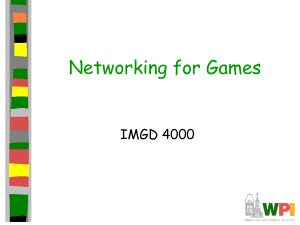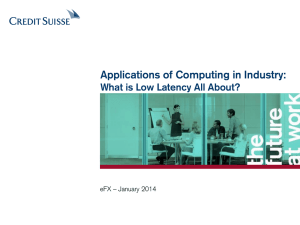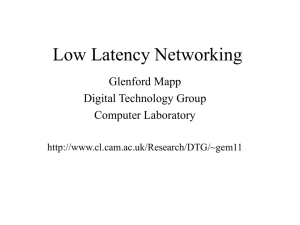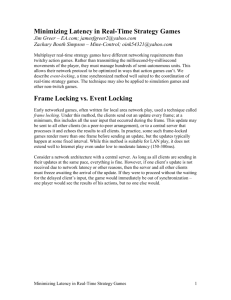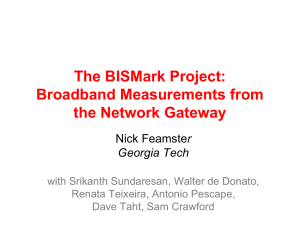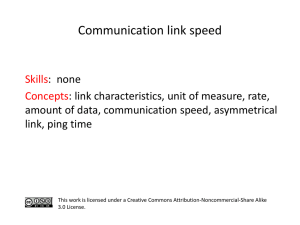Multiplayer Online Games PPT
advertisement
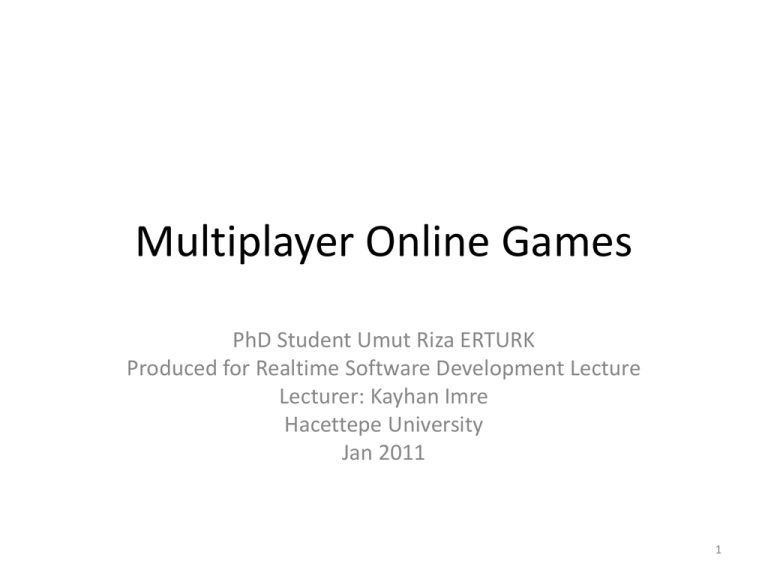
Multiplayer Online Games
PhD Student Umut Riza ERTURK
Produced for Realtime Software Development Lecture
Lecturer: Kayhan Imre
Hacettepe University
Jan 2011
1
What is a Multiplayer Game?
• More than one player at a time or NOT playing the
same game session
• Spacewar is the first multiplayer game and running
on a computer (1961) (made more than $100 000)
• Tennis for Two is the very first multiplayer game
running on an oscilloscope(1958)
Spacewar
Taken from http://en.wikipedia.org/wiki/Spacewar!
Tennis for Two
Taken from
http://en.wikipedia.org/wiki/Tennis_for_T
wo
2
What is an Online Game?
• In which players connect to devices remotely to play
• MUD 1 is one of the first online games, text based
• Basic client-server topology
MUD-1
Armitage p.9
3
Early Multiplayer Online Games
(Milestones)
• More than one player playing on the same game
session
• First example: Doom by ID software (1993)
– Using IPX for communication
– P2P (peer to peer topology)
– Every 1/35th of a second game collects user input and
broadcasts the network packets (sends it to other players)
– No sever, no client (or vice versa)
– Pros and cons? (discussion topic)
• Doom 2
– Same topology and method except for broadcasting
packets
4
Early Multiplayer Online Games
(Milestones)
• Quake (1996)
– Big leap in online gaming
– Server-client topology
– No Tunnelling (quake was using directly internet
protocols thus no need to convert wan packets into
different packets) which enabled players to play via
internet
– No need to meet in the same time and game room,
Quake had its own game rooms on internet
– Clients send only their own inputs to the server and
get back the new game state from the server
5
Communication Architectures for
Multiplayer Network Games
•
•
(a)Pure client: nothing but a client
(b)P2P: No servers, clients should
know each other
–
–
–
•
n*n connections might be needed
messaging traffic increases exponential as
new players join the game
Vulnerable to cheating
(c)Client-Server: One server which
knows clients but clients are not
aware of each other hence all the
messaging is passing through the
server
–
–
Needs a ‘strong’ server responding
consistently and fair to all clients
Makes voice chatting or data exchange btw
clients hard
6
Communication Architectures for
Multiplayer Network Games
•
(d)Hybrid Sever: Allows easy data
exchange between clients
–
–
–
•
Security problems may occur as clients
might be vulnerable to attacks
clients network might be kept busy by other
clients in purpose
Still needs a strong and consistent server
(d)Network of Servers : Allows hundred or even
thousands of people to be online like in
MMORPG games
– Costly
– Difficult to manage and maintain
7
Network Problems
• Latency, Jitter, Loss
– Latency
• Latency is the time spent for a packet to reach its
destination.
• Considered as half of Round Trip Time (send a data and get it
back) for symmetric networks
– Jitter
• Variations in latency
• Means inconsistency
– Loss
• Some packets gets lost (corrupted)
• Increases time spent for data exchange
8
Network Problems
• Causes of
– Latency
• Propagation delay which is a result of;
– Physical Limitations (speed of light is the upper limit for
communication)
– latency (ms) = (distance of link in kilometres)/300
• Serialisation; data is transferred in series of bits, all the bits
should arrive to the destination in a correct order to be
serialised which takes time
– latency (ms) = 8*(link layer frame length in bytes)/(link speed in
Kbps)
• Queuing delays; Switches doesn’t provide equally timeslots
for internet communication which means if the internet
traffic is heavy on a switch internet gets slow.
9
Network Problems
• Causes of
– Jitter
• Path length changes
– Data being sent doesn’t always use the same path on reaching
its destination
• Packet size changes
– Hence because of serialisation, sending time varies
10
Network Problems
• Causes of
– Loss
– Physical unrecoverable bit errors
– Dropping packets because of heavy communication traffic
11
How Network Games Tolerate
Network Problems
• Latency Compensation
– Why
• There will always be delays because of physical limitations
• Bandwidth is increasing but there are loads of packet loss
• Broadband communication speed varies from country to
country
• A Game should be
– Consistent
– Responsive
– Fair
– So we always need methods to compensate the
latency caused by network infrastructure
12
Latency Compensation
• The Simplest Client Side Algorithm of Network
Games
–
–
–
–
–
–
Collect user input
Pack up data and send it to server
Receive updates from server and unpack
Determine game state
Render scene
Repeat
13
Latency Compensation
• Outcome of the basic algorithm
– Client waits until server responses which
decreases the responsiveness of the game but
also makes the game consistent
14
Latency Compensation
• Prediction
– Player Prediction
• Client predicts player’s own movement and continues
movement
• Algorithm
–
–
–
–
–
–
–
Sample user input
Pack up data and send to server
Determine visible objects and game state
Render scene
Receive updates from server and upack
Fix up any discrepancies
Repeat.
15
Latency Compensation
•
Algorithm on the player to be predicted
• Sample user input
• Update {location | velocity | acceleration}
on the basis of new input
• Compute predicted location on the basis of
previous {location | velocity | acceleration}
• If (current location – predicted location) <
threshold then
• Pack up {location | velocity |
acceleration} data
• Send to each other opponent
• Repeat.
• Prediction
– Opponent Prediction
• Client predicts opponents’
movements
• Requires more data to be
transferred from other clients
in order to make a reasonable
prediction
• However, by not sending the
data if the difference is under
and threshold, data transfer
rate could be reduced
•
Algorithm on the opponent
• Receive new packet
• Extract state update information {location |
velocity | acceleration}
• If seen unit before then
• Update unit information
• Else
• Add unit information to list
• For each unit in list
• Update predicted location
• Render frame
• Repeat
16
Latency Compensation
• Prediction Summary
– Might be useful if a responsive but not that
consistent game
– What if a packet gets lost? And arrives afterwards
(in this case using UDP is not the best idea)
– Some situations are impossible to predict, i.e. 3
players running towards each other and tosses,
who tossed to whom first?
17
Latency Compensation
• Time Manipulation
– Some clients might have high latencies
– Game should be fair, consistent and responsive
– (example of collecting rewards)
18
Latency Compensation
• Time Manipulation
– Time Delay
• Server looks at the latencies and in order to maintain
the fairness and consistency adds some extra delay for
the ones has less latency
– Jitter is a problem here
– What if the client is showing its latency higher than it actually
is
19
Latency Compensation
• Time Manipulation
– Time Wrap
• Server looks at latency to the client
and rolls back the time as necessary
• Also protects from inconsistencies
caused by loss packets (as they
might not arrive in time order)
• May still cause inconsistencies i.e.
the player-1 is just moved to behind
of a wall and at that moment
player-2 shot, for player-1 bullet
bend and moved to the behind of
the wall (this may cause regularly if
jitter rate is high)
•
Algorithm on server side
• Receive packet from client
• Extract information (user input)
• Elapsed time = current time –
latency to client (rollback the time
to the clients time)
• Rollback all events in reverse
order to current time – elapsed
time
• Execute user command
• Repeat all events in order,
updating any clients affected
• Repeat.
20
Latency Compensation
• Sending less or compressed data
– Lossless compression: LZW algorithms for
compression of stream data
– Opponent prediction: Reduces the data sent
– Delta compression: Send the differences not the
whole data
– Interest Management: Send information of close
objects (don’t send distant objects’ information)
– P2P: Avoids sending data irrelevant data to the server
– Update Aggregation: Collect data for a client and sent
all the collected data at a time instead of sending
instant update data
21
Further reading topics
• Cheating Prevention
• Fair Randomness
22
Questions
23
Bibliography
– Armitage, G. , Claypool, M. , Branch, P.
(2006). Networking and Online Games. West
Sussex: John Wiley & Sons Ltd.
– Smed, J. , Hakonen, H. (2006). Algorithms and
Networking for Computer Games . West Sussex:
John Wiley & Sons Ltd.
– Barron, T. (2001). Multiplayer Game
Programming. California: Stacy L. Hiquet
24



